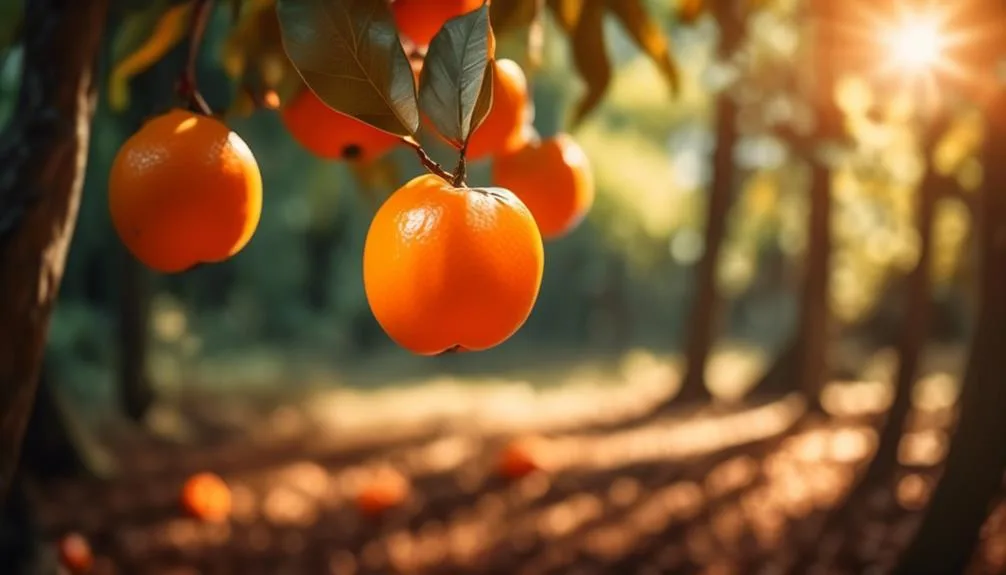There are more than 200 kinds of persimmon trees, and finding the wild ones can be like a treasure hunt. You might spot them in forests, along riverbanks, or in the countryside. Keep an eye out for these trees and you just might stumble upon their sweet, golden fruit.
Where exactly can you find them? Stick around to learn about the secret spots where these delightful trees like to hide.
Key Takeaways
- Wild persimmon trees can be found in woodlands, forests, riverbanks, streamsides, rural farmlands, parks, nature reserves, backroads, and country lanes.
- Look for trees with distinctive bark and vibrant orange fruits.
- These trees attract a variety of wildlife and offer foraging and harvesting opportunities.
- Proximity to streamsides ensures a reliable water source for the trees, while undisturbed environments in parks and nature reserves provide ideal conditions for their growth.
Woodlands and Forests
As you venture into the woodlands and forests, keep a keen eye out for the telltale signs of wild persimmon trees, such as their distinctive bark and vibrant orange fruits. These trees thrive in diverse habitats, attracting a variety of wildlife.
The dense foliage and fruit provide food and shelter for birds, deer, and other animals, creating a thriving ecosystem. In these natural settings, foraging and harvesting opportunities abound for those seeking the sweet and tangy taste of wild persimmons.
The abundance of wildlife and habitat in these areas also offers a unique opportunity to experience the interconnectedness of nature and the bounty it provides. Keep exploring these woodlands and forests, and you may just stumble upon the hidden treasure of wild persimmon trees, waiting to be discovered and savored.
Riverbanks and Streamsides
Meander along the riverbanks and streamsides, where the elusive wild persimmon trees may reveal themselves amidst the lush foliage and trickling waters. Here's what you need to know about riverbank ecosystems and streamside flora:
- Rich Biodiversity: Riverbank ecosystems harbor a diverse array of plant and animal species, providing a thriving environment for wild persimmon trees to flourish. The mix of moist soil and ample sunlight creates an ideal habitat for persimmon trees to thrive.
- Water Source: The proximity to streamsides ensures a reliable water source for wild persimmon trees, contributing to their growth and fruit production. The availability of water supports the development of persimmon fruits, making these areas prime spots for foraging.
- Ecological Importance: Streamside flora plays a crucial role in stabilizing riverbanks, preventing erosion, and providing food and shelter for wildlife, making it a promising location to seek out wild persimmon trees.
Exploring these riverbank and streamside areas can lead you to discovering the hidden treasures of wild persimmon trees.
Rural Farmlands
Have you ever wandered through the rural farmlands, scanning the horizon for the telltale signs of wild persimmon trees standing amidst the fields and pastures? When foraging in rural farmlands for wild persimmon trees, it's essential to keep a keen eye out for their distinct dark bark and orange fruits.
As you traverse the countryside, look for these trees in areas with well-drained soil and plenty of sunlight. During the seasonal harvest, which typically occurs in the fall, the trees' branches become laden with vibrant orange persimmons. Remember to bring a basket or a cloth bag for collecting the ripe fruits, and be sure to only pick the fully ripened ones for the best flavor.
With these foraging tips in mind, you'll be well-equipped to enjoy the bountiful harvest of wild persimmons in rural farmlands.
Parks and Nature Reserves
Wandering through parks and nature reserves, you can continue your quest to find wild persimmon trees. Seek out their distinctive dark bark and vibrant orange fruits amidst the natural beauty of these preserved landscapes.
As you embark on nature walks, keep an eye out for these elusive trees. They often thrive in the undisturbed environments of parks and reserves. While exploring, take the opportunity for birdwatching. Observe the diverse avian species that inhabit these areas.
Additionally, consider bringing along your camera for outdoor photography. Capture the breathtaking scenery and the unique appearance of wild persimmon trees. If you enjoy documenting your experiences, bring a nature journal. Record your observations and reflections as you immerse yourself in the tranquility of these natural settings.
Backroads and Country Lanes
As you navigate the countryside, keep an attentive eye out for the subtle signs of wild persimmon trees lining the backroads and country lanes, adding a touch of natural beauty to the rural landscape.
These often-overlooked routes can lead you to hidden orchards and remote groves where wild persimmon trees thrive.
Along the meandering backroads, the vibrant orange hue of ripe persimmons stands out against the green foliage, making for a picturesque sight.
The country lanes, flanked by hedgerows and old fences, offer a glimpse into the untouched beauty of nature.
Take your time to drive through these enchanting lanes, and you may be rewarded with the discovery of flourishing wild persimmon trees, their branches heavy with fruit, just waiting to be picked and enjoyed.
Conclusion
Keep an eye out for wild persimmon trees in woodlands, along riverbanks, in rural farmlands, at parks and nature reserves, and along backroads and country lanes.
You never know when you'll stumble upon a delicious and nutritious treat waiting to be picked.
Happy hunting, and may your explorations be fruitful!

